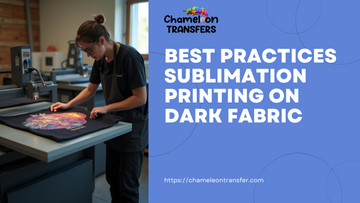
Achieving perfect prints with the right DTF heat press settings may feel like solving a puzzle. You’ve got your DTF transfers ready to press, your machine is turned on, and now it’s all about bringing everything together seamlessly.
But here’s the main question: How to set up the temperature? Too much heat, and you end up with a crispy mess; too little pressure, and your design simply won’t stick. It’s all about finding that perfect sweet spot.
So, we will walk you through how to optimize your DTF heat press settings for the best results, whether you’re just getting started or looking to take your prints to the next level.
What is a DTF Heat Press and How Does It Work?
A DTF heat press is designed and prepared for printing designs to any fabric using a combination of heat and pressure. First, ensure that the DTF printer settings are perfectly correct, then load the DTF transfer. Set the DTF heat press at the right temperature range. Before pressing, use parchment paper along with heat-resistant tape to allow even heat distribution.
Once heat and pressure are applied, follow the DTF temperature and time requirements for the best results. Always allow it to cool completely before peeling off the design to ensure proper adhering properly.
Always adjust the heat press settings based on your fabric type. The attention to detail you put into proper prepping will pay off by ensuring high-quality, professional results every time, extending the life of your prints and keeping them vibrant even after many washes.
What is the Best Temperature for Pressing DTF Transfers?

Mastering your DTF Heat Press Settings starts with understanding that different fabrics require slightly different handling, but the fundamentals remain the same: apply heat and pressure with precision.
First Press:
-
Position the image correctly on the garment.
-
Apply FIRM PRESSURE at 300°F to 315°F.
-
Use a guard sheet to protect both the fabric and design.
-
This method works well on cotton-poly blends, which respond well to these DTF transfer heat settings.
Second Press:
-
After peeling and checking the design, give it a second quick press.
-
Apply FIRM PRESSURE for 3–5 seconds to seal the design.
-
Ensure you're not pressing over seams, pockets, zippers, or buttons to ensure even heat distribution and proper adhesion.
For 100% Polyester:
-
Reduce the temperature to 250°F to 275°F.
-
This helps prevent fabric scorching and dye migration, critical when managing heat press temperature for polyester.
The key to success in DTF printing is experimenting with your specific machine to fine-tune your time and temperature settings for DTF printing, pressure, and fabric types. Always adjust your heat press settings accordingly and use consistent, optimal DTF heat press pressure for the best results.
How Long Do you press the DTF Transfers?
The pressing time for DTF transfers plays a big role in how well your design adheres to the fabric. If you get the timing wrong, you might face common DTF printing problems like cracking, peeling, or poor colour transfer. That’s why setting the correct DTF heat press settings is essential for professional results.
For cotton and cotton-blend garments, press the transfer for 10–13 seconds at a temperature of 300°F to 315°F using firm pressure. After peeling, apply a second press for 3–5 seconds to seal the design properly. These are the recommended DTF transfer heat settings for most fabric types.
When pressing 100% polyester, it's important to reduce the time to 7–8 seconds and lower the temperature to 250°F to 275°F to prevent fabric damage. Always double-check your printer settings for DTF before starting, as incorrect print quality or ink saturation can affect the final transfer.
Also Read: What Does DTF Stand For? Understanding DTF Printing & Its Benefits
What is The Best Peeling Method for DTF Transfers?

The peeling method you choose is crucial for achieving the best results with your DTF transfers. There are three common methods: Cold Peel, Warm Peel, and Hot Peel.
-
Cold Peel: The most preferred method. Allow the transfer to cool completely before peeling for strong adhesion and durability, ideal for most DTF curing process setups.
-
Warm Peel: Peel gently while the transfer is still warm. This method provides a balance of speed and control.
-
Hot Peel: Peel immediately after pressing. This requires precision, as improper peeling can lead to errors.
Make sure your DTF Heat Press Settings, Time and temperature settings for DTF printing, and how long do you press a DTF transfer are correct for the best results. Always know what temp do you press DTF transfers at to ensure clean and consistent transfers.
Common Heat Press Mistakes That Ruin Your DTF Prints
When working with DTF transfers, certain mistakes with your heat press can lead to ruined prints. Here are some common heat press errors to avoid for optimal results:
1. Incorrect DTF Heat Press Settings can lead to poor results. Not adjusting the temperature or pressure settings properly can cause the transfer to either not adhere well or become damaged.
2. Failing to set the time and temperature settings for DTF printing accurately can ruin your prints. Pressing for too long or at the wrong temperature often results in designs that crack, fade, or peel prematurely.
3. Not understanding what temp do you press DTF transfers at can cause issues like dye migration or improper adhesion.
4. Using improper heat press settings, like not ensuring even pressure across the entire surface, can lead to uneven transfers and distorted prints.
Tips to Make Your DTF Prints Last Longer
To ensure your DTF prints stand best from the crowd, it's important to follow the right techniques and practices. Here are some valuable tips:
-
Use high-quality transfer films to ensure better ink adhesion and longevity. The right film will hold the design better and withstand washing, keeping your prints sharp and vibrant.
-
After pressing, always apply a guard sheet to protect the design from excess heat and pressure, which can cause fading or damage over time. This step helps maintain the print's appearance.
-
Proper care after pressing is essential for longevity. Wash garments inside out and avoid high heat settings during drying to prevent cracking or fading of the design, preserving the print’s life.
Regularly check your DTF Heat Press Settings to ensure they’re still optimal for the material you're working with. As fabric types vary, make sure your press is correctly adjusted to help avoid unnecessary wear and tear on the transfer.
Conclusion
Getting your DTF Heat Press Settings right can be the difference between a print that fades and one that lasts. With the correct temperature, time, and pressure, you ensure every transfer is vibrant, durable, and professionally finished. Whether you're just starting out or fine-tuning your process, mastering your settings is key to success.
At Chameleon Transfers, we specialise in turning your ideas into wearable art, stunning décor, and more through high-quality DTF printing. Our mission is to deliver unmatched product quality and innovative solutions tailored to your needs.
Visit us and discover the difference that expert printing can make.
FAQs
Q: What temperature should I heat press DTF at?
Set your DTF Heat Press Settings between 300°F–315°F for most fabrics. Adjust based on your DTF transfer heat settings and fabric type for best results.
Q: What are the best heat press settings for DTF?
The best heat press for DTF transfers uses firm pressure, 300°F–315°F for 10–13 seconds. Always fine-tune your DTF Heat Press Settings based on material and film.
Q: How to do a DTF transfer with heat press?
Use proper printer settings for DTF, align the film, and press at 300–315°F for 10–13 seconds. Re-press for 3–5 sec. Follow the correct DTF transfer heat settings for success.
Q: What are the DTF settings for 100 cotton?
For 100% cotton, apply firm pressure at 300–315°F for 10–13 seconds. Stick to proper DTF Heat Press Settings and use the right printer settings for DTF for clean results.
Also read more related blogs: 
What is UV DTF Transfers and How Do They Work?



